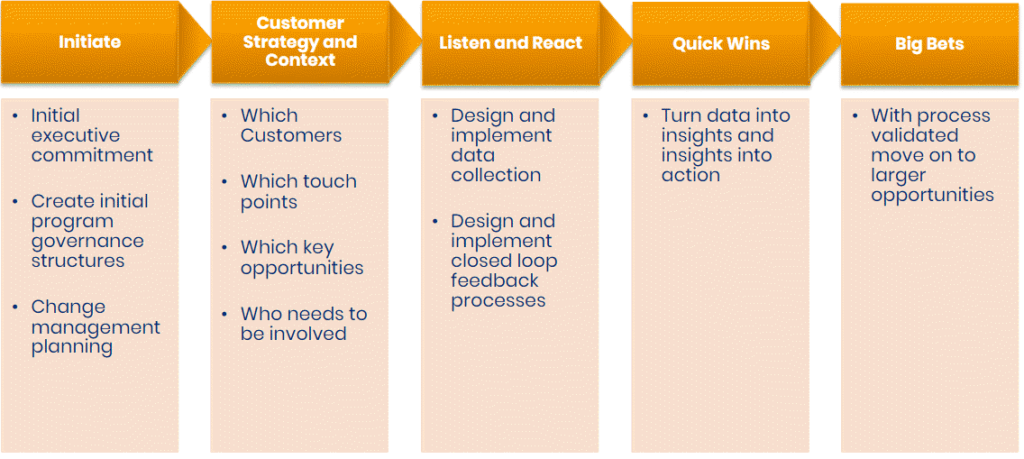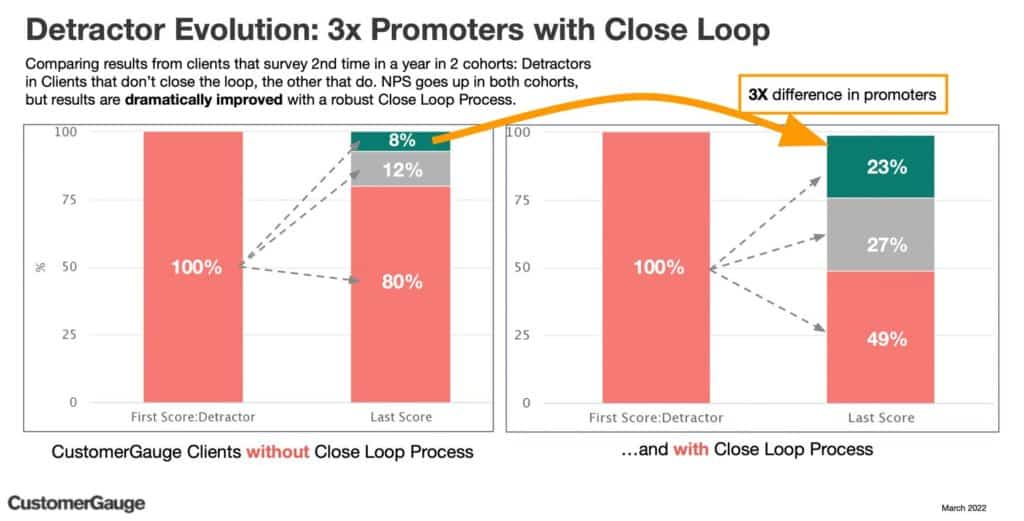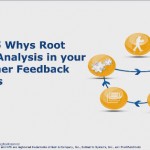What is a Voice of The Customer Program
A Voice of the Customer (VoC) Program is the process by which a company listens to, understands and acts on feedback from its customers regarding the company, its products and services.
A great VoC program is not just about sending out a survey and creating some charts. It’s about aligning the company with it’s customers’ needs in order to grow company value.
Benefits of a VoC Program
There are three main benefits of a VoC program:
- Increased customer loyalty;
- Lower costs;
- Increased sales
Each of these benefits is achieved by using customer feedback to deliver products and services that more closely match customer needs and thereby increase customer customer loyalty and customer satisfaction.
How to Launch Your VoC Program
Most organisations start their VoC program by sending a customer feedback survey to their customers. This works in the short term but long term it fails to set the organisation up for success.
Long term success is built on creating a VoC process that collects VoC information and then puts it to use changing and improving the business.
Here are the five steps to launch a great Voice of the Customer program:

Step 1: Initiate – Executive Commitment, Design Governance and Change Management
First you should ensure that senior management are engaged in the process. They control the budgets (time and money) that you need to be successful so they need to believe and understand the goals of the VoC program.
Investing in a Governance process that is appropriate and as simple as possible will ensure ongoing support and clarity for the program.
Lastly, consider how you will introduce the change to the rest of the organisation. Running a simple change management workshop will help leverage supporters and convert those not convinced.
Step 2: Develop a Simple Customer Journey Map
Before launching a survey it is important to identify the important customer touchpoints and segments in your business so you can focus the VoC data collection on the right parts parts of your business.
Create a customer feedback based customer journey map to help guide you in the rollout.
Step 3: Create Survey and Close the Loop
Now you have everyone’s attention, know the key touchpoints and customers you can design your targeted VoC survey to capture the right information from the right customers at the right touchpoints.
This is also the right time to design how you will respond to clients when they complete the survey. Research shows that reacting quickly and directly to negative feedback can dramatically lift your customer rating.
Step 4: VoC Quick Wins
Having received a good number of survey responses you should start making changes to your business as soon as possible.
It is very common to find some quick and easy wins from the initial set of customer feedback. Improving customer perception can sometimes be as simple as changing an onboarding email or updating a few pages on your website.
These small changes can often have a disproportionate impact on improving customer loyalty. Do them quickly and prove the value of the program.
Step 5: Big Bets
With some solid quick wins behind you it’s time to start looking at bigger changes that require higher levels of investment and, typically, businesses cases.
Having proved your process using Quick Wins will help your credibility when getting the business case approved.
The Best Voice of the Customer Program Metrics
Most VoC programs will settle on having one or two key metrics to track progress. While there are any number of metrics you could use, here are the three most common Voice of Customer program metric.
Net Promoter Score
Net Promoter Score, or NPS® is well known and has been proven to be a valid predictor of customer loyalty and so makes a good candidate as a high level VoC tracking measure.
To determine NPS® the following question is added to an organisation’s customer feedback survey.

Once the data is collected, Net Promoter Score is calculated by subtracting the percentage of 0-6 responses (Detractors), from the percentage of 9 and 10 responses (Promoters). 7 and 8 responses (Neutrals) are ignored.
Here is the NPS calculation in a formula:

Customer Satisfaction Score or CSAT
Customer Satisfaction Scores attempt to measure how satisfied customers are with the performance of the company. The assumption being that the more satisfied a customer is the more likely that are to stay as a customer.
CSAT was the first metric to be commonly used in VoC programs but it can be a little unreliable as a customer loyalty indicator so is not used as often in modern programs.

Customer Effort Score
Launched in the 2010 Harvard Business Review article “Stop trying to delight your customers”, Customer Effort Score (CES) is less popular than NPS as a metric but is occasionally used.

It has been shown to be a good predictor of customer loyalty but is generally only applicable to front line (contact centres, retail locations, etc) settings and so needs to be carefully considered if being considered as a VoC metric.
VoC Program Best Practices
There are lots of detailed best practices you can apply to your voice of the customer program but the most important are:
Launch Quickly and Iterate
It can be easy to get lost in the process of setting up your VoC program and spend far too long designing the perfect program. In practice you learn far more in the two days after putting out your first survey than you will by trying to perfect every last detail.
Launch as quickly as you can then iterate the program to improve.
Read Every Comment
Maybe it sounds simple and straightforward but it doesn’t always occur. One of the most important things you can do is to read every comment that customers provide.
Apart from the obvious, because the customer wrote them, they provide the detailed insights you can use to innovate and improve.
Act on What you Hear with Root Cause Analysis
It is not enough to listen to the Voice of the customer, you have to act on it as well.
This is the key. Your VoC program is just a way of identifying what you need to change. To improve you then have to use the information to identify and make changes to better align the business to customer needs.
Close the Loop
By being quick to respond and, where possible, resolving customer issues you will often turn people around from singing your shortfalls to singing your praises.
Here’s the proof: CustomerGauge compared the scores of NPS survey respondents year on year and found organisations that close the loop convert 3x more Detractors to Promoters than those that don’t. Plus you halve the number of Detractors.











